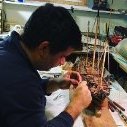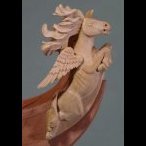MORE HANDBOOKS ARE ON THEIR WAY! We will let you know when they get here.
×
-
Posts
1,197 -
Joined
-
Last visited
Reputation Activity
-
 Stuntflyer got a reaction from FrankWouts in Sloop Speedwell 1752 by Stuntflyer (Mike) - Ketch Rigged Sloop - POF
Stuntflyer got a reaction from FrankWouts in Sloop Speedwell 1752 by Stuntflyer (Mike) - Ketch Rigged Sloop - POF
Aft deadwood, stern post, wedges
With the addition of these parts, the central spine is finished. The stern post and the steps in the deadwood were cut on the mill. The straight taper in the deadwood, from the bearding line down to the foot, was done as described in Chuck's build log. There is a lot more wood to remove here than you might think. I often checked the work with a straight edge to insure that the final taper was straight and not rounded. More sanding will be needed later when it comes time to fair the cant frames.
Mike
-
 Stuntflyer got a reaction from FrankWouts in Sloop Speedwell 1752 by Stuntflyer (Mike) - Ketch Rigged Sloop - POF
Stuntflyer got a reaction from FrankWouts in Sloop Speedwell 1752 by Stuntflyer (Mike) - Ketch Rigged Sloop - POF
Mike, thank you!
-
 Stuntflyer got a reaction from FrankWouts in Sloop Speedwell 1752 by Stuntflyer (Mike) - Ketch Rigged Sloop - POF
Stuntflyer got a reaction from FrankWouts in Sloop Speedwell 1752 by Stuntflyer (Mike) - Ketch Rigged Sloop - POF
Stemson, rising wood
Moving along, I added the stemson and rising wood. Shaping and adding the stemson was straight forward. After that, I started work on the rising wood. Using a piece of 3/8" boxwood, I carefully copied the dimensions of the rising wood using the new milling machine. So much fun! All of the slots are 5/16" which made the process much easier. Basically a two day process that went along quite smoothly. I just needed to stay focused and not rush through it.
Mike
-
 Stuntflyer got a reaction from FrankWouts in Sloop Speedwell 1752 by Stuntflyer (Mike) - Ketch Rigged Sloop - POF
Stuntflyer got a reaction from FrankWouts in Sloop Speedwell 1752 by Stuntflyer (Mike) - Ketch Rigged Sloop - POF
Tom, I do have DRO. Thanks for the tip on a slitting saw.
-
 Stuntflyer got a reaction from FrankWouts in Sloop Speedwell 1752 by Stuntflyer (Mike) - Ketch Rigged Sloop - POF
Stuntflyer got a reaction from FrankWouts in Sloop Speedwell 1752 by Stuntflyer (Mike) - Ketch Rigged Sloop - POF
Fore deadwood
In order to find the exact location, I aligned the central spine with the plan and carefully marked the aft location of the fore deadwood.
Having just purchased a Sherline mill, I thought it would be a good time to try it out. With that in mind I made the fore deadwood from 3/8" boxwood. I'm pleased with the result. I added the deadwood to the keel using the registration mark I made on the keel.
As I mentioned earlier, I'm going to maintain the build concept. With that in mind I went with the laser cut angle wedges for the cant frames. A mix of scratch and kit. When adding the wedges I left a little wiggle room because shifting of these pieces was necessary in order to align them fore and aft. The tops of the wedges were reduced to match the shape of the keelson before gluing them to the deadwood.
Mike
-
 Stuntflyer got a reaction from Vladimir_Wairoa in Sloop Speedwell 1752 by Stuntflyer (Mike) - Ketch Rigged Sloop - POF
Stuntflyer got a reaction from Vladimir_Wairoa in Sloop Speedwell 1752 by Stuntflyer (Mike) - Ketch Rigged Sloop - POF
Fred, I have often thought about showing, in great detail, how I go about making parts. The problem I always seem to run into is how to go about doing it knowing that certain subtle techniques are involved.
Take the stem for example. As Greg knows, the oscillating spindle sander on curved surfaces can give a smoother result than that of a scroll saw. That gets you somewhere in the ball park. The final shape still needs to be achieved and can be further honed in with some 90° sanding blocks. For myself, I will hold the pieces against a window in daylight and look for light leakage. It can be very time consuming and the back and forth takes technique, finesse and a lot of patience. HTH.
The gammoning knee was cut from an attached paper template on the scroll saw. The final shape was achieved with the disk sander, sanding sticks, #11 Xacto blade and assorted needle files. It would be very difficult for me to put that in writing in such a way that would be easily understood, I think.
Mike
-
 Stuntflyer got a reaction from FrankWouts in Sloop Speedwell 1752 by Stuntflyer (Mike) - Ketch Rigged Sloop - POF
Stuntflyer got a reaction from FrankWouts in Sloop Speedwell 1752 by Stuntflyer (Mike) - Ketch Rigged Sloop - POF
Mark, Thank you!
Rusty, I can't wait to see my approach to the frames as well. I guess I'll figure it out when I get there.
-
 Stuntflyer got a reaction from FrankWouts in Sloop Speedwell 1752 by Stuntflyer (Mike) - Ketch Rigged Sloop - POF
Stuntflyer got a reaction from FrankWouts in Sloop Speedwell 1752 by Stuntflyer (Mike) - Ketch Rigged Sloop - POF
Hi Dave,
Thanks for your interest. Have you considered starting a build log? It would be interesting to see a POB version.
Continuing with some catch up on my progress so far.
Keel
This is all very similar to what I did on the Winchelsea. The lower stem has a true boxing joint. The straight lengths of keel were made from two layers of 5/32” sheet which were offset, thus creating the half lap joint. The first section I added was the one that attaches to the knee and stem assembly. Additional keel sections were added to that by working aft. The false keel and rabbet strip were then cut and added to the keel.
For the keel bolts I used (.023) 30 pound black fishing line. The only change I made was to use a No. 73 bit instead of a No. 71. It provided the snug fit I was looking for. Holes were drilled about 1/8” deep.
Mike
-
 Stuntflyer got a reaction from GioMun in Sloop Speedwell 1752 by Stuntflyer (Mike) - Ketch Rigged Sloop - POF
Stuntflyer got a reaction from GioMun in Sloop Speedwell 1752 by Stuntflyer (Mike) - Ketch Rigged Sloop - POF
Square tuck
I wanted to give this a try at least once before making use of the laser cut versions. #1. I copied the angle from the laser cut piece onto the joined strips. #2. The frame was made and set parallel with the angled line. #3. The curves were done with the spindle sander and disc sander along with a bit of hand work. #4. Almost ready to place on the ship. I Still needed to taper the frame.
The most difficult part was trying to get symmetry between the two sides. It's not perfect, but certainly close enough. I was kicking myself when I noticed that the top of the port side square tuck is 1/64" lower at the stern post compared to the other one. Of course this won't be seen once the moulding is on. I left the outer area of the frames without any tapering. There is a tiny filler plank that goes between the tuck and the first strake. I will wait until that's on the ship, so I can sand that area all at the same time.
Anyway only one shot at it for this result.
Mike
-
 Stuntflyer got a reaction from shipcarpenter in Sloop Speedwell 1752 by Stuntflyer (Mike) - Ketch Rigged Sloop - POF
Stuntflyer got a reaction from shipcarpenter in Sloop Speedwell 1752 by Stuntflyer (Mike) - Ketch Rigged Sloop - POF
Square tuck
I wanted to give this a try at least once before making use of the laser cut versions. #1. I copied the angle from the laser cut piece onto the joined strips. #2. The frame was made and set parallel with the angled line. #3. The curves were done with the spindle sander and disc sander along with a bit of hand work. #4. Almost ready to place on the ship. I Still needed to taper the frame.
The most difficult part was trying to get symmetry between the two sides. It's not perfect, but certainly close enough. I was kicking myself when I noticed that the top of the port side square tuck is 1/64" lower at the stern post compared to the other one. Of course this won't be seen once the moulding is on. I left the outer area of the frames without any tapering. There is a tiny filler plank that goes between the tuck and the first strake. I will wait until that's on the ship, so I can sand that area all at the same time.
Anyway only one shot at it for this result.
Mike
-
 Stuntflyer got a reaction from yvesvidal in Sloop Speedwell 1752 by Stuntflyer (Mike) - Ketch Rigged Sloop - POF
Stuntflyer got a reaction from yvesvidal in Sloop Speedwell 1752 by Stuntflyer (Mike) - Ketch Rigged Sloop - POF
Square tuck
I wanted to give this a try at least once before making use of the laser cut versions. #1. I copied the angle from the laser cut piece onto the joined strips. #2. The frame was made and set parallel with the angled line. #3. The curves were done with the spindle sander and disc sander along with a bit of hand work. #4. Almost ready to place on the ship. I Still needed to taper the frame.
The most difficult part was trying to get symmetry between the two sides. It's not perfect, but certainly close enough. I was kicking myself when I noticed that the top of the port side square tuck is 1/64" lower at the stern post compared to the other one. Of course this won't be seen once the moulding is on. I left the outer area of the frames without any tapering. There is a tiny filler plank that goes between the tuck and the first strake. I will wait until that's on the ship, so I can sand that area all at the same time.
Anyway only one shot at it for this result.
Mike
-
 Stuntflyer got a reaction from Trussben in Sloop Speedwell 1752 by Stuntflyer (Mike) - Ketch Rigged Sloop - POF
Stuntflyer got a reaction from Trussben in Sloop Speedwell 1752 by Stuntflyer (Mike) - Ketch Rigged Sloop - POF
Square tuck
I wanted to give this a try at least once before making use of the laser cut versions. #1. I copied the angle from the laser cut piece onto the joined strips. #2. The frame was made and set parallel with the angled line. #3. The curves were done with the spindle sander and disc sander along with a bit of hand work. #4. Almost ready to place on the ship. I Still needed to taper the frame.
The most difficult part was trying to get symmetry between the two sides. It's not perfect, but certainly close enough. I was kicking myself when I noticed that the top of the port side square tuck is 1/64" lower at the stern post compared to the other one. Of course this won't be seen once the moulding is on. I left the outer area of the frames without any tapering. There is a tiny filler plank that goes between the tuck and the first strake. I will wait until that's on the ship, so I can sand that area all at the same time.
Anyway only one shot at it for this result.
Mike
-
 Stuntflyer got a reaction from Mike Y in Sloop Speedwell 1752 by Stuntflyer (Mike) - Ketch Rigged Sloop - POF
Stuntflyer got a reaction from Mike Y in Sloop Speedwell 1752 by Stuntflyer (Mike) - Ketch Rigged Sloop - POF
Square tuck
I wanted to give this a try at least once before making use of the laser cut versions. #1. I copied the angle from the laser cut piece onto the joined strips. #2. The frame was made and set parallel with the angled line. #3. The curves were done with the spindle sander and disc sander along with a bit of hand work. #4. Almost ready to place on the ship. I Still needed to taper the frame.
The most difficult part was trying to get symmetry between the two sides. It's not perfect, but certainly close enough. I was kicking myself when I noticed that the top of the port side square tuck is 1/64" lower at the stern post compared to the other one. Of course this won't be seen once the moulding is on. I left the outer area of the frames without any tapering. There is a tiny filler plank that goes between the tuck and the first strake. I will wait until that's on the ship, so I can sand that area all at the same time.
Anyway only one shot at it for this result.
Mike
-
 Stuntflyer got a reaction from KARAVOKIRIS in Sloop Speedwell 1752 by Stuntflyer (Mike) - Ketch Rigged Sloop - POF
Stuntflyer got a reaction from KARAVOKIRIS in Sloop Speedwell 1752 by Stuntflyer (Mike) - Ketch Rigged Sloop - POF
Square tuck
I wanted to give this a try at least once before making use of the laser cut versions. #1. I copied the angle from the laser cut piece onto the joined strips. #2. The frame was made and set parallel with the angled line. #3. The curves were done with the spindle sander and disc sander along with a bit of hand work. #4. Almost ready to place on the ship. I Still needed to taper the frame.
The most difficult part was trying to get symmetry between the two sides. It's not perfect, but certainly close enough. I was kicking myself when I noticed that the top of the port side square tuck is 1/64" lower at the stern post compared to the other one. Of course this won't be seen once the moulding is on. I left the outer area of the frames without any tapering. There is a tiny filler plank that goes between the tuck and the first strake. I will wait until that's on the ship, so I can sand that area all at the same time.
Anyway only one shot at it for this result.
Mike
-
 Stuntflyer got a reaction from GrandpaPhil in Sloop Speedwell 1752 by Stuntflyer (Mike) - Ketch Rigged Sloop - POF
Stuntflyer got a reaction from GrandpaPhil in Sloop Speedwell 1752 by Stuntflyer (Mike) - Ketch Rigged Sloop - POF
Square tuck
I wanted to give this a try at least once before making use of the laser cut versions. #1. I copied the angle from the laser cut piece onto the joined strips. #2. The frame was made and set parallel with the angled line. #3. The curves were done with the spindle sander and disc sander along with a bit of hand work. #4. Almost ready to place on the ship. I Still needed to taper the frame.
The most difficult part was trying to get symmetry between the two sides. It's not perfect, but certainly close enough. I was kicking myself when I noticed that the top of the port side square tuck is 1/64" lower at the stern post compared to the other one. Of course this won't be seen once the moulding is on. I left the outer area of the frames without any tapering. There is a tiny filler plank that goes between the tuck and the first strake. I will wait until that's on the ship, so I can sand that area all at the same time.
Anyway only one shot at it for this result.
Mike
-
 Stuntflyer got a reaction from mtaylor in Sloop Speedwell 1752 by Stuntflyer (Mike) - Ketch Rigged Sloop - POF
Stuntflyer got a reaction from mtaylor in Sloop Speedwell 1752 by Stuntflyer (Mike) - Ketch Rigged Sloop - POF
Square tuck
I wanted to give this a try at least once before making use of the laser cut versions. #1. I copied the angle from the laser cut piece onto the joined strips. #2. The frame was made and set parallel with the angled line. #3. The curves were done with the spindle sander and disc sander along with a bit of hand work. #4. Almost ready to place on the ship. I Still needed to taper the frame.
The most difficult part was trying to get symmetry between the two sides. It's not perfect, but certainly close enough. I was kicking myself when I noticed that the top of the port side square tuck is 1/64" lower at the stern post compared to the other one. Of course this won't be seen once the moulding is on. I left the outer area of the frames without any tapering. There is a tiny filler plank that goes between the tuck and the first strake. I will wait until that's on the ship, so I can sand that area all at the same time.
Anyway only one shot at it for this result.
Mike
-
 Stuntflyer got a reaction from TomShipModel in Sloop Speedwell 1752 by Stuntflyer (Mike) - Ketch Rigged Sloop - POF
Stuntflyer got a reaction from TomShipModel in Sloop Speedwell 1752 by Stuntflyer (Mike) - Ketch Rigged Sloop - POF
Square tuck
I wanted to give this a try at least once before making use of the laser cut versions. #1. I copied the angle from the laser cut piece onto the joined strips. #2. The frame was made and set parallel with the angled line. #3. The curves were done with the spindle sander and disc sander along with a bit of hand work. #4. Almost ready to place on the ship. I Still needed to taper the frame.
The most difficult part was trying to get symmetry between the two sides. It's not perfect, but certainly close enough. I was kicking myself when I noticed that the top of the port side square tuck is 1/64" lower at the stern post compared to the other one. Of course this won't be seen once the moulding is on. I left the outer area of the frames without any tapering. There is a tiny filler plank that goes between the tuck and the first strake. I will wait until that's on the ship, so I can sand that area all at the same time.
Anyway only one shot at it for this result.
Mike
-
 Stuntflyer got a reaction from Alexander Bulimov in Sloop Speedwell 1752 by Stuntflyer (Mike) - Ketch Rigged Sloop - POF
Stuntflyer got a reaction from Alexander Bulimov in Sloop Speedwell 1752 by Stuntflyer (Mike) - Ketch Rigged Sloop - POF
Square tuck
I wanted to give this a try at least once before making use of the laser cut versions. #1. I copied the angle from the laser cut piece onto the joined strips. #2. The frame was made and set parallel with the angled line. #3. The curves were done with the spindle sander and disc sander along with a bit of hand work. #4. Almost ready to place on the ship. I Still needed to taper the frame.
The most difficult part was trying to get symmetry between the two sides. It's not perfect, but certainly close enough. I was kicking myself when I noticed that the top of the port side square tuck is 1/64" lower at the stern post compared to the other one. Of course this won't be seen once the moulding is on. I left the outer area of the frames without any tapering. There is a tiny filler plank that goes between the tuck and the first strake. I will wait until that's on the ship, so I can sand that area all at the same time.
Anyway only one shot at it for this result.
Mike
-
 Stuntflyer got a reaction from Ryland Craze in Sloop Speedwell 1752 by Stuntflyer (Mike) - Ketch Rigged Sloop - POF
Stuntflyer got a reaction from Ryland Craze in Sloop Speedwell 1752 by Stuntflyer (Mike) - Ketch Rigged Sloop - POF
Square tuck
I wanted to give this a try at least once before making use of the laser cut versions. #1. I copied the angle from the laser cut piece onto the joined strips. #2. The frame was made and set parallel with the angled line. #3. The curves were done with the spindle sander and disc sander along with a bit of hand work. #4. Almost ready to place on the ship. I Still needed to taper the frame.
The most difficult part was trying to get symmetry between the two sides. It's not perfect, but certainly close enough. I was kicking myself when I noticed that the top of the port side square tuck is 1/64" lower at the stern post compared to the other one. Of course this won't be seen once the moulding is on. I left the outer area of the frames without any tapering. There is a tiny filler plank that goes between the tuck and the first strake. I will wait until that's on the ship, so I can sand that area all at the same time.
Anyway only one shot at it for this result.
Mike
-
 Stuntflyer got a reaction from TBlack in Sloop Speedwell 1752 by Stuntflyer (Mike) - Ketch Rigged Sloop - POF
Stuntflyer got a reaction from TBlack in Sloop Speedwell 1752 by Stuntflyer (Mike) - Ketch Rigged Sloop - POF
Square tuck
I wanted to give this a try at least once before making use of the laser cut versions. #1. I copied the angle from the laser cut piece onto the joined strips. #2. The frame was made and set parallel with the angled line. #3. The curves were done with the spindle sander and disc sander along with a bit of hand work. #4. Almost ready to place on the ship. I Still needed to taper the frame.
The most difficult part was trying to get symmetry between the two sides. It's not perfect, but certainly close enough. I was kicking myself when I noticed that the top of the port side square tuck is 1/64" lower at the stern post compared to the other one. Of course this won't be seen once the moulding is on. I left the outer area of the frames without any tapering. There is a tiny filler plank that goes between the tuck and the first strake. I will wait until that's on the ship, so I can sand that area all at the same time.
Anyway only one shot at it for this result.
Mike
-
 Stuntflyer got a reaction from Nunnehi (Don) in Sloop Speedwell 1752 by Stuntflyer (Mike) - Ketch Rigged Sloop - POF
Stuntflyer got a reaction from Nunnehi (Don) in Sloop Speedwell 1752 by Stuntflyer (Mike) - Ketch Rigged Sloop - POF
Square tuck
I wanted to give this a try at least once before making use of the laser cut versions. #1. I copied the angle from the laser cut piece onto the joined strips. #2. The frame was made and set parallel with the angled line. #3. The curves were done with the spindle sander and disc sander along with a bit of hand work. #4. Almost ready to place on the ship. I Still needed to taper the frame.
The most difficult part was trying to get symmetry between the two sides. It's not perfect, but certainly close enough. I was kicking myself when I noticed that the top of the port side square tuck is 1/64" lower at the stern post compared to the other one. Of course this won't be seen once the moulding is on. I left the outer area of the frames without any tapering. There is a tiny filler plank that goes between the tuck and the first strake. I will wait until that's on the ship, so I can sand that area all at the same time.
Anyway only one shot at it for this result.
Mike
-
 Stuntflyer got a reaction from yvesvidal in Sloop Speedwell 1752 by Stuntflyer (Mike) - Ketch Rigged Sloop - POF
Stuntflyer got a reaction from yvesvidal in Sloop Speedwell 1752 by Stuntflyer (Mike) - Ketch Rigged Sloop - POF
As you know, Chuck faired the hull with the top jigs in place. After supporting the hull with some planking, he was able to remove the jigs and add the fairing caps for both shape and support. Through hands on experience he knows that this approach will work out nicely. I wasn't so sure that it would work out the same for me. I was concerned that after removing the top timber jigs, I would find myself having to fair the hull a lot more. This would be quite difficult with the planking already on the hull. With that in mind, I decided to take a different approach.
I added a chock between each frame where they would be covered by planking. Adding the chocks meant that I could pull the laser cut top timber jigs (before doing any planking) while maintaining support for the frames. After adding the fairing caps, I could fair the hull more accurately at the shear. Generally this turned out to be true at least for me. There were some areas at the shear that needed more work, but an inch or so below the shear the fairing work was good. Yes, a few hours of extra work that turned out well in the end.
Notice that there is still enough room for the .025" cap rail to sit just below the top of the transom.
There was an enormous amount of work needed to fair these aft cants. It took me the better part of three days. Remember this is boxwood, not AYC. Anyway that's done now.😁
Mike
-
 Stuntflyer got a reaction from yvesvidal in Sloop Speedwell 1752 by Stuntflyer (Mike) - Ketch Rigged Sloop - POF
Stuntflyer got a reaction from yvesvidal in Sloop Speedwell 1752 by Stuntflyer (Mike) - Ketch Rigged Sloop - POF
Window sills
I will admit that these were quite tricky to make. Different angles everywhere and some trial and error was needed in order to get them just right. I probably had 3 or 4 throwaways before getting the ones you see here.
Stern frames
In order to make these, I sandwiched two roughly cut frames together with some Elmer's School Glue and then adhered the plan drawing for final shaping. This was easy enough to do with the help of the spindle sander, disk sander and scroll saw.
Transom
On top of the shear there will be a 5/32" fairing cap and a 1/4" cap rail that sits on top of that. The two pieces will add a total of about 3/32" more height to the top of the shear. I wouldn't want the cap rail to protrude above the top edge of the transom. With that in mind, I decided to fair the quarter deck shear before adding the transom. This way I could check the clearance before adding the transom. It was really just a matter of getting that small triangular piece taken down to the right height while fairing the shear.
I added the 5/32" fairing cap for the quarter deck and faired the outer hull using the cap as a guide.
Mike
-
 Stuntflyer got a reaction from yvesvidal in Sloop Speedwell 1752 by Stuntflyer (Mike) - Ketch Rigged Sloop - POF
Stuntflyer got a reaction from yvesvidal in Sloop Speedwell 1752 by Stuntflyer (Mike) - Ketch Rigged Sloop - POF
Framing (final pieces)
I have finally finished all of the framing. About nine months to do them all including about 160 milled scarph joints. It certainly feels like a milestone. Though mostly done, I still need to do some minor cleanup fairing, especially where the cants transition into the deadwood.
FYI: Here is the fit that I was shooting for when adding the last frame, #29.
Mike
-
 Stuntflyer got a reaction from yvesvidal in Sloop Speedwell 1752 by Stuntflyer (Mike) - Ketch Rigged Sloop - POF
Stuntflyer got a reaction from yvesvidal in Sloop Speedwell 1752 by Stuntflyer (Mike) - Ketch Rigged Sloop - POF
I was hoping for a little more progress this week. The problem was that I started nit picking.
One of the things that I've been wanting to do from the beginning was to avoid any color matching with paint for areas that might not have turned out as expected. Typically that would be something like an open butt joint or where two different wood types join together thus changing the uniformity of the look.
Looking at this closeup photo from my previous post, it's not hard to see that the AYC quarter panel is a lighter color than the end grain of the wing transom which is made from boxwood.
The lower section of the quarter panel for the most part is covered by planking. However, some of the lighter AYC color will be seen after the planking is completed. Knowing that, I decided to remove some of the AYC from the quarter piece and replace it with boxwood. Actually, it was quite easy to do and I was able to complete the work in less than an hour. See photo below.
Fashion piece
The fashion piece was cut from 5/32" sheet. The tricky part was getting a nice flow into the bearding line and a good joint along the deadwood and wing transom. I ended up having to make two of these in order to get the one I liked. I left the top of the fashion piece standing proud. Also, I left some of the paper template attached which could be used as a sanding template. I recommend doing this rather than trying to get a perfect fit everywhere. It's hard to explain as to why, just that it's easier to fit the piece and fair the top into the wing transom afterwards. If I end up back into nit picking mode, I might do a bit more work at the bearding line transition.
Also, note that the boxwood filler is in and mostly faired.
Mike











